Improving London Underground Accessibility for Disabled People
VerifiedAdded on 2023/01/16
|13
|3059
|89
Report
AI Summary
This report critically analyzes the accessibility of the London Underground for individuals with learning disabilities, addressing challenges such as step-free access, information provision, and staff training. It examines issues like overcrowding, route changes, and inconsiderate behavior from other commuters, particularly during peak hours. The report highlights the impact of these barriers on travel plans, modal choices, and safety concerns. It evaluates the implications of these challenges, including the need for improved staff training, better information dissemination, and enhanced physical accessibility. The report proposes solutions such as increased staff presence, diversity training, and improved infrastructure to enhance the travel experience for disabled commuters. It concludes with recommendations for governmental action to address educational and employment gaps, ensuring accessible services, and promoting the inclusion of disabled individuals in civic life, emphasizing their autonomy and decision-making power.

Sociology
Name
Institution
Professor
Course
Date
Name
Institution
Professor
Course
Date
Paraphrase This Document
Need a fresh take? Get an instant paraphrase of this document with our AI Paraphraser
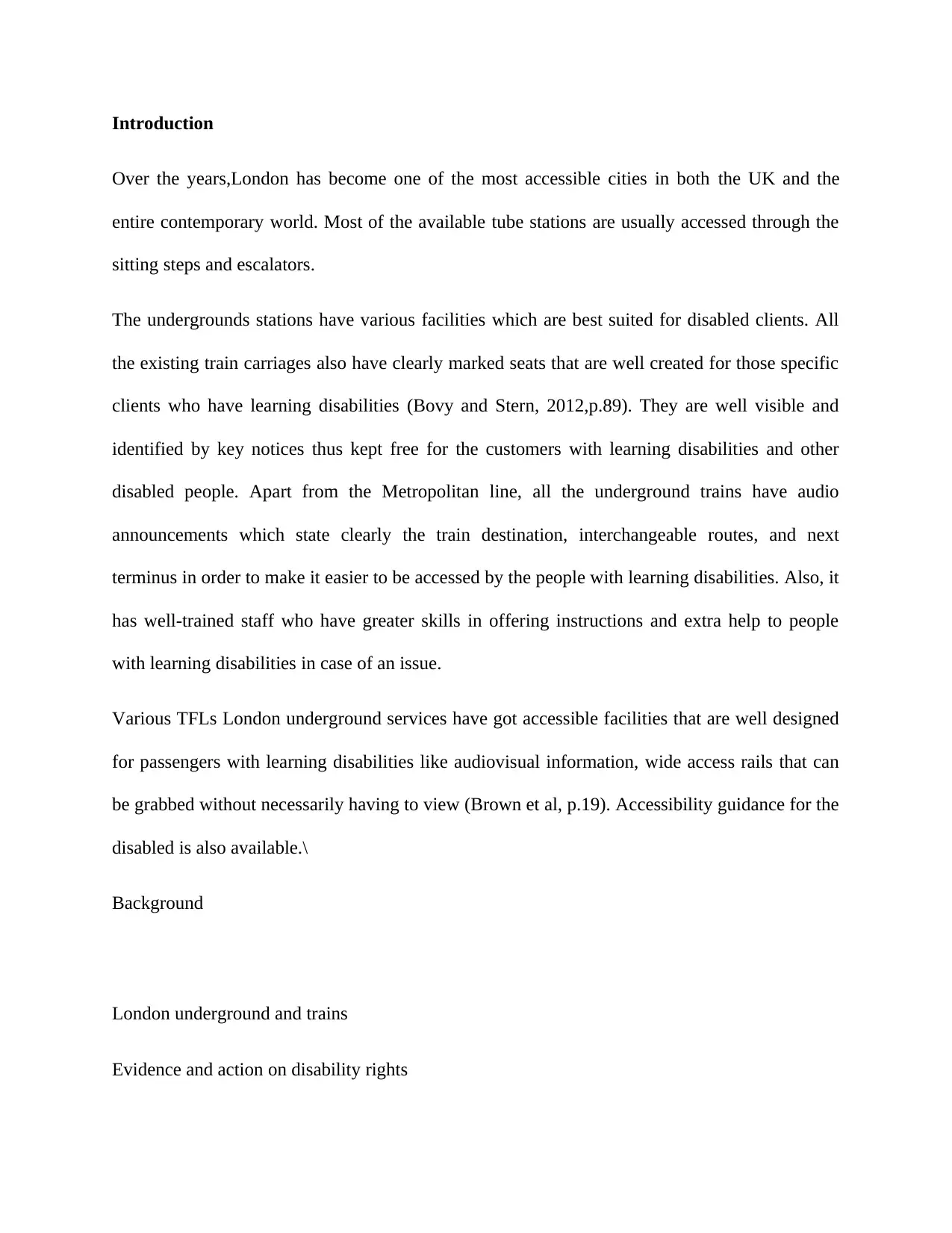
Introduction
Over the years,London has become one of the most accessible cities in both the UK and the
entire contemporary world. Most of the available tube stations are usually accessed through the
sitting steps and escalators.
The undergrounds stations have various facilities which are best suited for disabled clients. All
the existing train carriages also have clearly marked seats that are well created for those specific
clients who have learning disabilities (Bovy and Stern, 2012,p.89). They are well visible and
identified by key notices thus kept free for the customers with learning disabilities and other
disabled people. Apart from the Metropolitan line, all the underground trains have audio
announcements which state clearly the train destination, interchangeable routes, and next
terminus in order to make it easier to be accessed by the people with learning disabilities. Also, it
has well-trained staff who have greater skills in offering instructions and extra help to people
with learning disabilities in case of an issue.
Various TFLs London underground services have got accessible facilities that are well designed
for passengers with learning disabilities like audiovisual information, wide access rails that can
be grabbed without necessarily having to view (Brown et al, p.19). Accessibility guidance for the
disabled is also available.\
Background
London underground and trains
Evidence and action on disability rights
Over the years,London has become one of the most accessible cities in both the UK and the
entire contemporary world. Most of the available tube stations are usually accessed through the
sitting steps and escalators.
The undergrounds stations have various facilities which are best suited for disabled clients. All
the existing train carriages also have clearly marked seats that are well created for those specific
clients who have learning disabilities (Bovy and Stern, 2012,p.89). They are well visible and
identified by key notices thus kept free for the customers with learning disabilities and other
disabled people. Apart from the Metropolitan line, all the underground trains have audio
announcements which state clearly the train destination, interchangeable routes, and next
terminus in order to make it easier to be accessed by the people with learning disabilities. Also, it
has well-trained staff who have greater skills in offering instructions and extra help to people
with learning disabilities in case of an issue.
Various TFLs London underground services have got accessible facilities that are well designed
for passengers with learning disabilities like audiovisual information, wide access rails that can
be grabbed without necessarily having to view (Brown et al, p.19). Accessibility guidance for the
disabled is also available.\
Background
London underground and trains
Evidence and action on disability rights
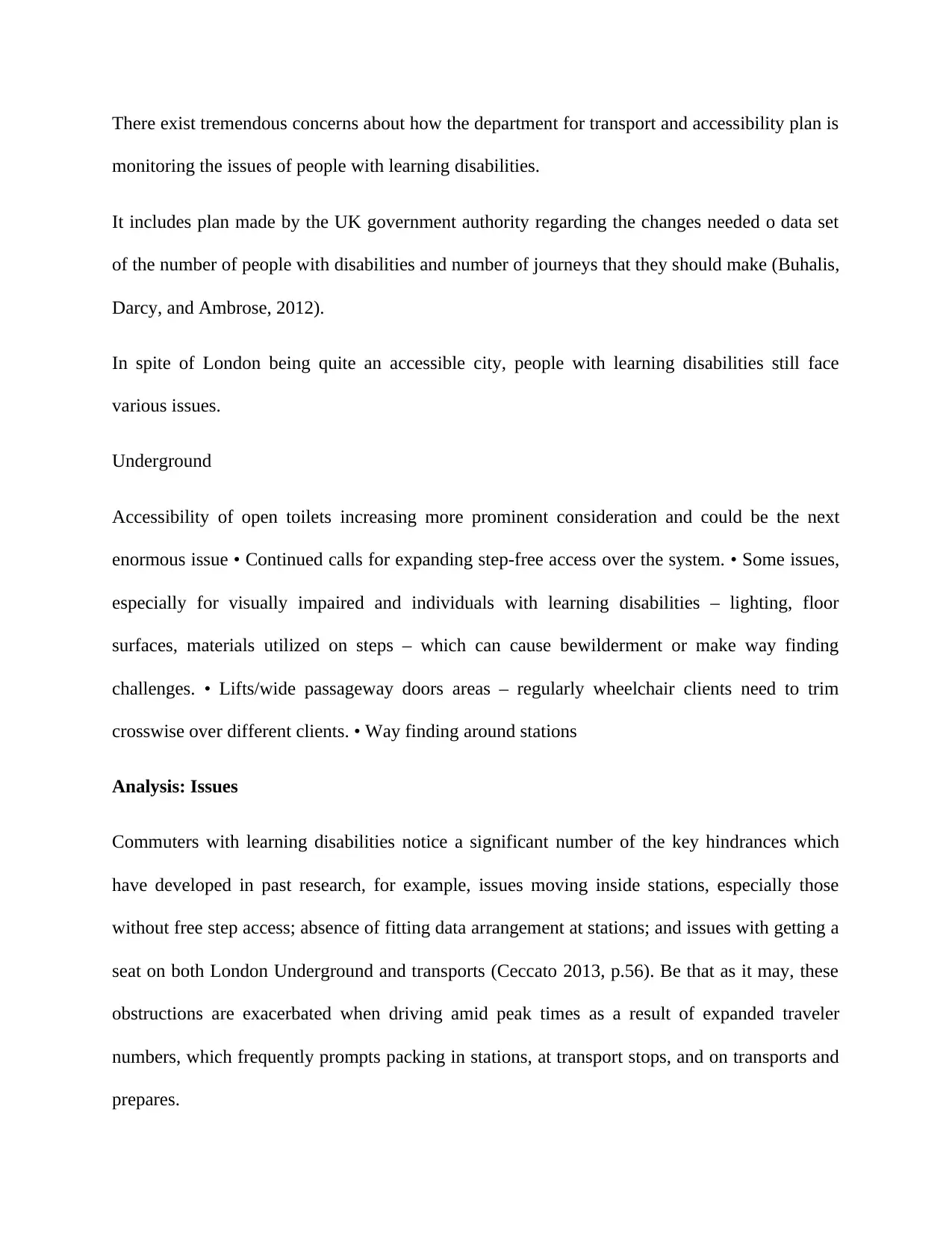
There exist tremendous concerns about how the department for transport and accessibility plan is
monitoring the issues of people with learning disabilities.
It includes plan made by the UK government authority regarding the changes needed o data set
of the number of people with disabilities and number of journeys that they should make (Buhalis,
Darcy, and Ambrose, 2012).
In spite of London being quite an accessible city, people with learning disabilities still face
various issues.
Underground
Accessibility of open toilets increasing more prominent consideration and could be the next
enormous issue • Continued calls for expanding step-free access over the system. • Some issues,
especially for visually impaired and individuals with learning disabilities – lighting, floor
surfaces, materials utilized on steps – which can cause bewilderment or make way finding
challenges. • Lifts/wide passageway doors areas – regularly wheelchair clients need to trim
crosswise over different clients. • Way finding around stations
Analysis: Issues
Commuters with learning disabilities notice a significant number of the key hindrances which
have developed in past research, for example, issues moving inside stations, especially those
without free step access; absence of fitting data arrangement at stations; and issues with getting a
seat on both London Underground and transports (Ceccato 2013, p.56). Be that as it may, these
obstructions are exacerbated when driving amid peak times as a result of expanded traveler
numbers, which frequently prompts packing in stations, at transport stops, and on transports and
prepares.
monitoring the issues of people with learning disabilities.
It includes plan made by the UK government authority regarding the changes needed o data set
of the number of people with disabilities and number of journeys that they should make (Buhalis,
Darcy, and Ambrose, 2012).
In spite of London being quite an accessible city, people with learning disabilities still face
various issues.
Underground
Accessibility of open toilets increasing more prominent consideration and could be the next
enormous issue • Continued calls for expanding step-free access over the system. • Some issues,
especially for visually impaired and individuals with learning disabilities – lighting, floor
surfaces, materials utilized on steps – which can cause bewilderment or make way finding
challenges. • Lifts/wide passageway doors areas – regularly wheelchair clients need to trim
crosswise over different clients. • Way finding around stations
Analysis: Issues
Commuters with learning disabilities notice a significant number of the key hindrances which
have developed in past research, for example, issues moving inside stations, especially those
without free step access; absence of fitting data arrangement at stations; and issues with getting a
seat on both London Underground and transports (Ceccato 2013, p.56). Be that as it may, these
obstructions are exacerbated when driving amid peak times as a result of expanded traveler
numbers, which frequently prompts packing in stations, at transport stops, and on transports and
prepares.
⊘ This is a preview!⊘
Do you want full access?
Subscribe today to unlock all pages.

Trusted by 1+ million students worldwide
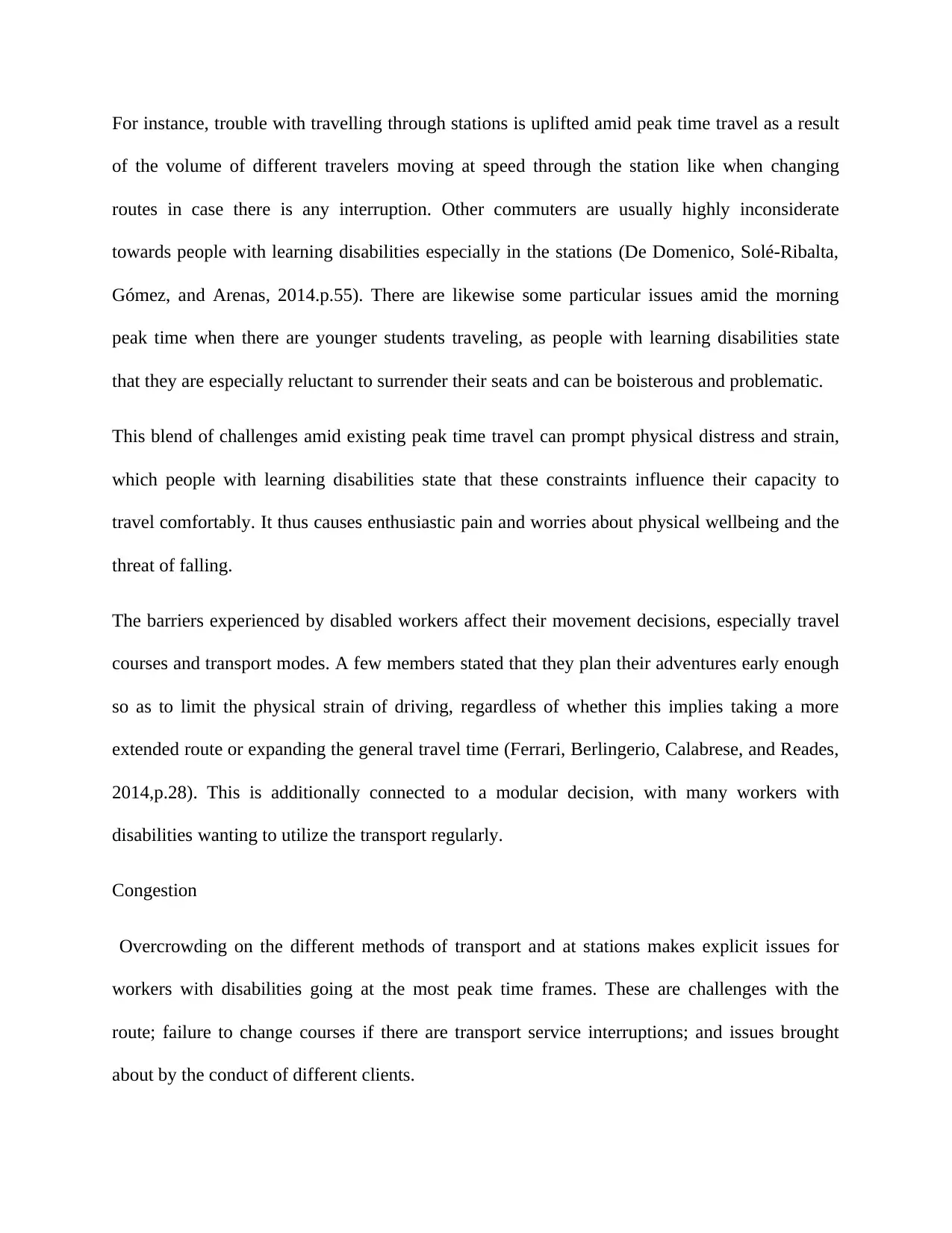
For instance, trouble with travelling through stations is uplifted amid peak time travel as a result
of the volume of different travelers moving at speed through the station like when changing
routes in case there is any interruption. Other commuters are usually highly inconsiderate
towards people with learning disabilities especially in the stations (De Domenico, Solé-Ribalta,
Gómez, and Arenas, 2014.p.55). There are likewise some particular issues amid the morning
peak time when there are younger students traveling, as people with learning disabilities state
that they are especially reluctant to surrender their seats and can be boisterous and problematic.
This blend of challenges amid existing peak time travel can prompt physical distress and strain,
which people with learning disabilities state that these constraints influence their capacity to
travel comfortably. It thus causes enthusiastic pain and worries about physical wellbeing and the
threat of falling.
The barriers experienced by disabled workers affect their movement decisions, especially travel
courses and transport modes. A few members stated that they plan their adventures early enough
so as to limit the physical strain of driving, regardless of whether this implies taking a more
extended route or expanding the general travel time (Ferrari, Berlingerio, Calabrese, and Reades,
2014,p.28). This is additionally connected to a modular decision, with many workers with
disabilities wanting to utilize the transport regularly.
Congestion
Overcrowding on the different methods of transport and at stations makes explicit issues for
workers with disabilities going at the most peak time frames. These are challenges with the
route; failure to change courses if there are transport service interruptions; and issues brought
about by the conduct of different clients.
of the volume of different travelers moving at speed through the station like when changing
routes in case there is any interruption. Other commuters are usually highly inconsiderate
towards people with learning disabilities especially in the stations (De Domenico, Solé-Ribalta,
Gómez, and Arenas, 2014.p.55). There are likewise some particular issues amid the morning
peak time when there are younger students traveling, as people with learning disabilities state
that they are especially reluctant to surrender their seats and can be boisterous and problematic.
This blend of challenges amid existing peak time travel can prompt physical distress and strain,
which people with learning disabilities state that these constraints influence their capacity to
travel comfortably. It thus causes enthusiastic pain and worries about physical wellbeing and the
threat of falling.
The barriers experienced by disabled workers affect their movement decisions, especially travel
courses and transport modes. A few members stated that they plan their adventures early enough
so as to limit the physical strain of driving, regardless of whether this implies taking a more
extended route or expanding the general travel time (Ferrari, Berlingerio, Calabrese, and Reades,
2014,p.28). This is additionally connected to a modular decision, with many workers with
disabilities wanting to utilize the transport regularly.
Congestion
Overcrowding on the different methods of transport and at stations makes explicit issues for
workers with disabilities going at the most peak time frames. These are challenges with the
route; failure to change courses if there are transport service interruptions; and issues brought
about by the conduct of different clients.
Paraphrase This Document
Need a fresh take? Get an instant paraphrase of this document with our AI Paraphraser
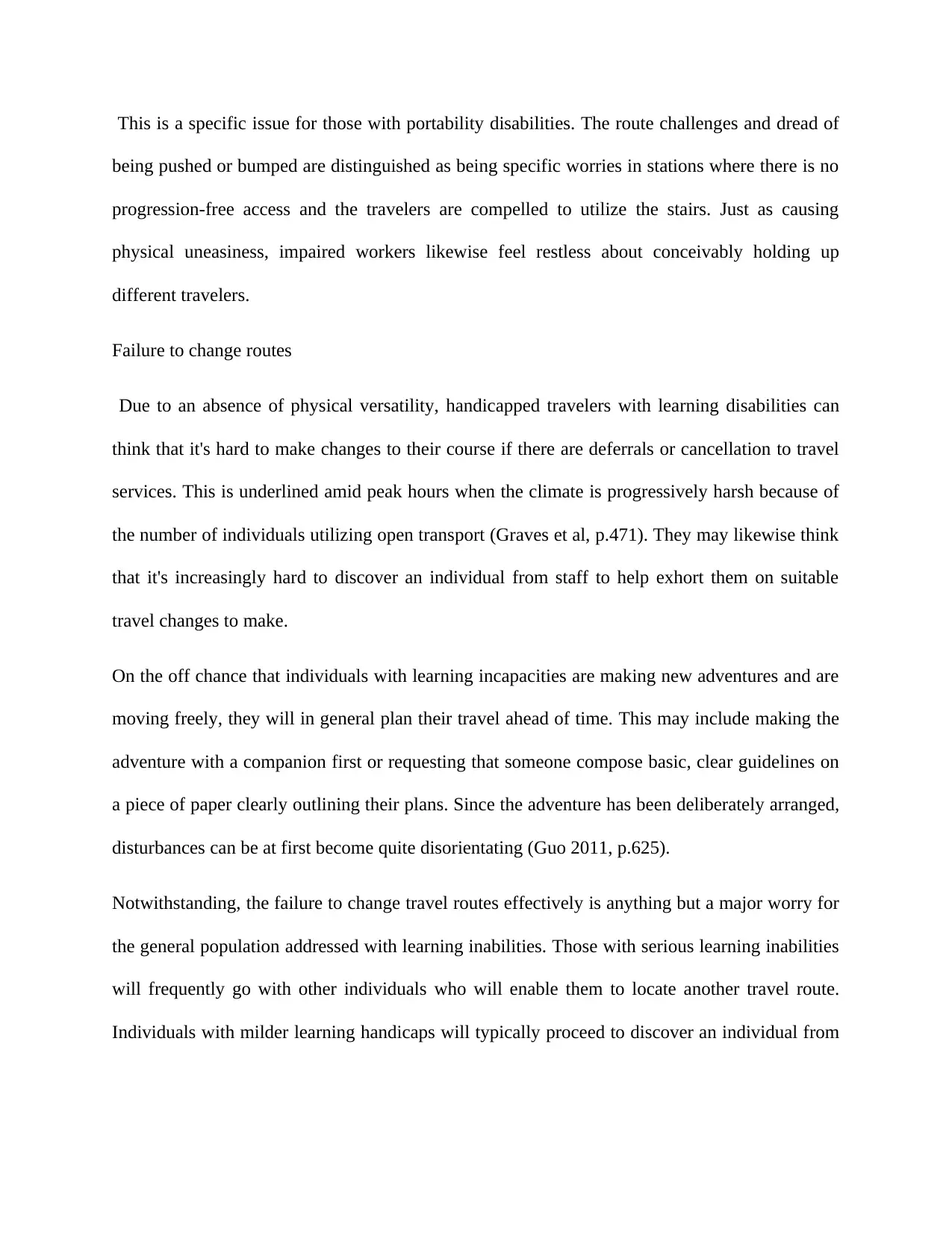
This is a specific issue for those with portability disabilities. The route challenges and dread of
being pushed or bumped are distinguished as being specific worries in stations where there is no
progression-free access and the travelers are compelled to utilize the stairs. Just as causing
physical uneasiness, impaired workers likewise feel restless about conceivably holding up
different travelers.
Failure to change routes
Due to an absence of physical versatility, handicapped travelers with learning disabilities can
think that it's hard to make changes to their course if there are deferrals or cancellation to travel
services. This is underlined amid peak hours when the climate is progressively harsh because of
the number of individuals utilizing open transport (Graves et al, p.471). They may likewise think
that it's increasingly hard to discover an individual from staff to help exhort them on suitable
travel changes to make.
On the off chance that individuals with learning incapacities are making new adventures and are
moving freely, they will in general plan their travel ahead of time. This may include making the
adventure with a companion first or requesting that someone compose basic, clear guidelines on
a piece of paper clearly outlining their plans. Since the adventure has been deliberately arranged,
disturbances can be at first become quite disorientating (Guo 2011, p.625).
Notwithstanding, the failure to change travel routes effectively is anything but a major worry for
the general population addressed with learning inabilities. Those with serious learning inabilities
will frequently go with other individuals who will enable them to locate another travel route.
Individuals with milder learning handicaps will typically proceed to discover an individual from
being pushed or bumped are distinguished as being specific worries in stations where there is no
progression-free access and the travelers are compelled to utilize the stairs. Just as causing
physical uneasiness, impaired workers likewise feel restless about conceivably holding up
different travelers.
Failure to change routes
Due to an absence of physical versatility, handicapped travelers with learning disabilities can
think that it's hard to make changes to their course if there are deferrals or cancellation to travel
services. This is underlined amid peak hours when the climate is progressively harsh because of
the number of individuals utilizing open transport (Graves et al, p.471). They may likewise think
that it's increasingly hard to discover an individual from staff to help exhort them on suitable
travel changes to make.
On the off chance that individuals with learning incapacities are making new adventures and are
moving freely, they will in general plan their travel ahead of time. This may include making the
adventure with a companion first or requesting that someone compose basic, clear guidelines on
a piece of paper clearly outlining their plans. Since the adventure has been deliberately arranged,
disturbances can be at first become quite disorientating (Guo 2011, p.625).
Notwithstanding, the failure to change travel routes effectively is anything but a major worry for
the general population addressed with learning inabilities. Those with serious learning inabilities
will frequently go with other individuals who will enable them to locate another travel route.
Individuals with milder learning handicaps will typically proceed to discover an individual from
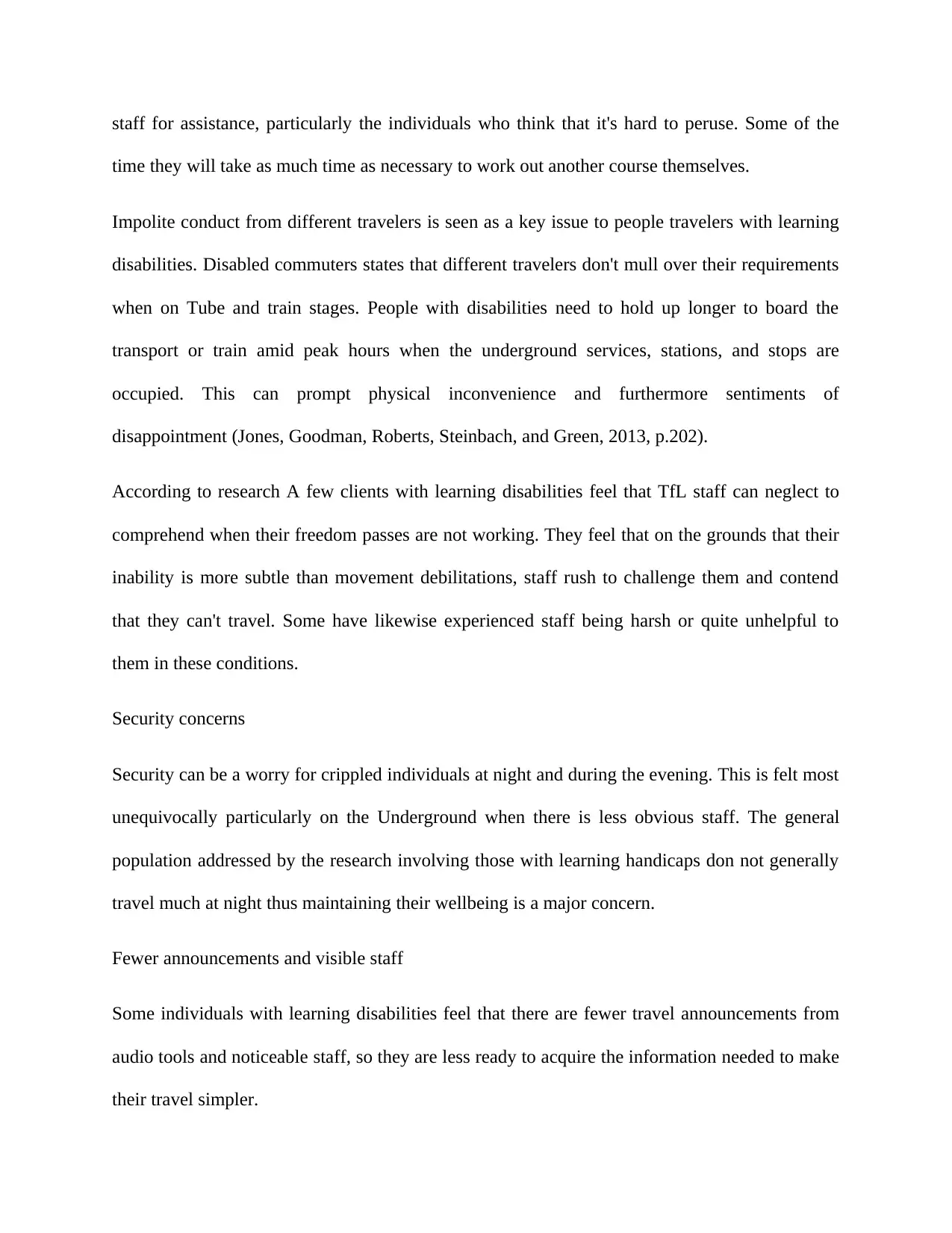
staff for assistance, particularly the individuals who think that it's hard to peruse. Some of the
time they will take as much time as necessary to work out another course themselves.
Impolite conduct from different travelers is seen as a key issue to people travelers with learning
disabilities. Disabled commuters states that different travelers don't mull over their requirements
when on Tube and train stages. People with disabilities need to hold up longer to board the
transport or train amid peak hours when the underground services, stations, and stops are
occupied. This can prompt physical inconvenience and furthermore sentiments of
disappointment (Jones, Goodman, Roberts, Steinbach, and Green, 2013, p.202).
According to research A few clients with learning disabilities feel that TfL staff can neglect to
comprehend when their freedom passes are not working. They feel that on the grounds that their
inability is more subtle than movement debilitations, staff rush to challenge them and contend
that they can't travel. Some have likewise experienced staff being harsh or quite unhelpful to
them in these conditions.
Security concerns
Security can be a worry for crippled individuals at night and during the evening. This is felt most
unequivocally particularly on the Underground when there is less obvious staff. The general
population addressed by the research involving those with learning handicaps don not generally
travel much at night thus maintaining their wellbeing is a major concern.
Fewer announcements and visible staff
Some individuals with learning disabilities feel that there are fewer travel announcements from
audio tools and noticeable staff, so they are less ready to acquire the information needed to make
their travel simpler.
time they will take as much time as necessary to work out another course themselves.
Impolite conduct from different travelers is seen as a key issue to people travelers with learning
disabilities. Disabled commuters states that different travelers don't mull over their requirements
when on Tube and train stages. People with disabilities need to hold up longer to board the
transport or train amid peak hours when the underground services, stations, and stops are
occupied. This can prompt physical inconvenience and furthermore sentiments of
disappointment (Jones, Goodman, Roberts, Steinbach, and Green, 2013, p.202).
According to research A few clients with learning disabilities feel that TfL staff can neglect to
comprehend when their freedom passes are not working. They feel that on the grounds that their
inability is more subtle than movement debilitations, staff rush to challenge them and contend
that they can't travel. Some have likewise experienced staff being harsh or quite unhelpful to
them in these conditions.
Security concerns
Security can be a worry for crippled individuals at night and during the evening. This is felt most
unequivocally particularly on the Underground when there is less obvious staff. The general
population addressed by the research involving those with learning handicaps don not generally
travel much at night thus maintaining their wellbeing is a major concern.
Fewer announcements and visible staff
Some individuals with learning disabilities feel that there are fewer travel announcements from
audio tools and noticeable staff, so they are less ready to acquire the information needed to make
their travel simpler.
⊘ This is a preview!⊘
Do you want full access?
Subscribe today to unlock all pages.

Trusted by 1+ million students worldwide
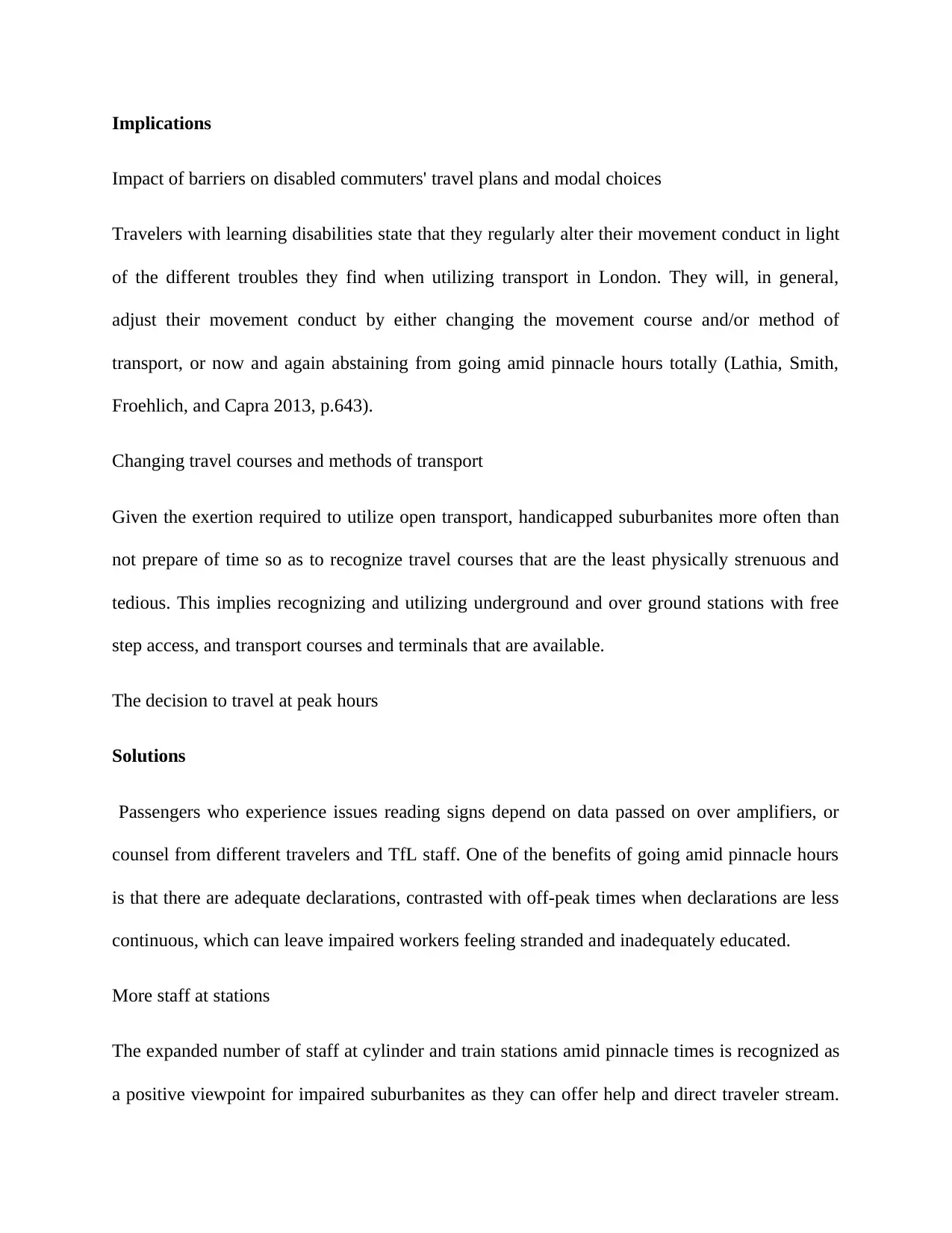
Implications
Impact of barriers on disabled commuters' travel plans and modal choices
Travelers with learning disabilities state that they regularly alter their movement conduct in light
of the different troubles they find when utilizing transport in London. They will, in general,
adjust their movement conduct by either changing the movement course and/or method of
transport, or now and again abstaining from going amid pinnacle hours totally (Lathia, Smith,
Froehlich, and Capra 2013, p.643).
Changing travel courses and methods of transport
Given the exertion required to utilize open transport, handicapped suburbanites more often than
not prepare of time so as to recognize travel courses that are the least physically strenuous and
tedious. This implies recognizing and utilizing underground and over ground stations with free
step access, and transport courses and terminals that are available.
The decision to travel at peak hours
Solutions
Passengers who experience issues reading signs depend on data passed on over amplifiers, or
counsel from different travelers and TfL staff. One of the benefits of going amid pinnacle hours
is that there are adequate declarations, contrasted with off-peak times when declarations are less
continuous, which can leave impaired workers feeling stranded and inadequately educated.
More staff at stations
The expanded number of staff at cylinder and train stations amid pinnacle times is recognized as
a positive viewpoint for impaired suburbanites as they can offer help and direct traveler stream.
Impact of barriers on disabled commuters' travel plans and modal choices
Travelers with learning disabilities state that they regularly alter their movement conduct in light
of the different troubles they find when utilizing transport in London. They will, in general,
adjust their movement conduct by either changing the movement course and/or method of
transport, or now and again abstaining from going amid pinnacle hours totally (Lathia, Smith,
Froehlich, and Capra 2013, p.643).
Changing travel courses and methods of transport
Given the exertion required to utilize open transport, handicapped suburbanites more often than
not prepare of time so as to recognize travel courses that are the least physically strenuous and
tedious. This implies recognizing and utilizing underground and over ground stations with free
step access, and transport courses and terminals that are available.
The decision to travel at peak hours
Solutions
Passengers who experience issues reading signs depend on data passed on over amplifiers, or
counsel from different travelers and TfL staff. One of the benefits of going amid pinnacle hours
is that there are adequate declarations, contrasted with off-peak times when declarations are less
continuous, which can leave impaired workers feeling stranded and inadequately educated.
More staff at stations
The expanded number of staff at cylinder and train stations amid pinnacle times is recognized as
a positive viewpoint for impaired suburbanites as they can offer help and direct traveler stream.
Paraphrase This Document
Need a fresh take? Get an instant paraphrase of this document with our AI Paraphraser
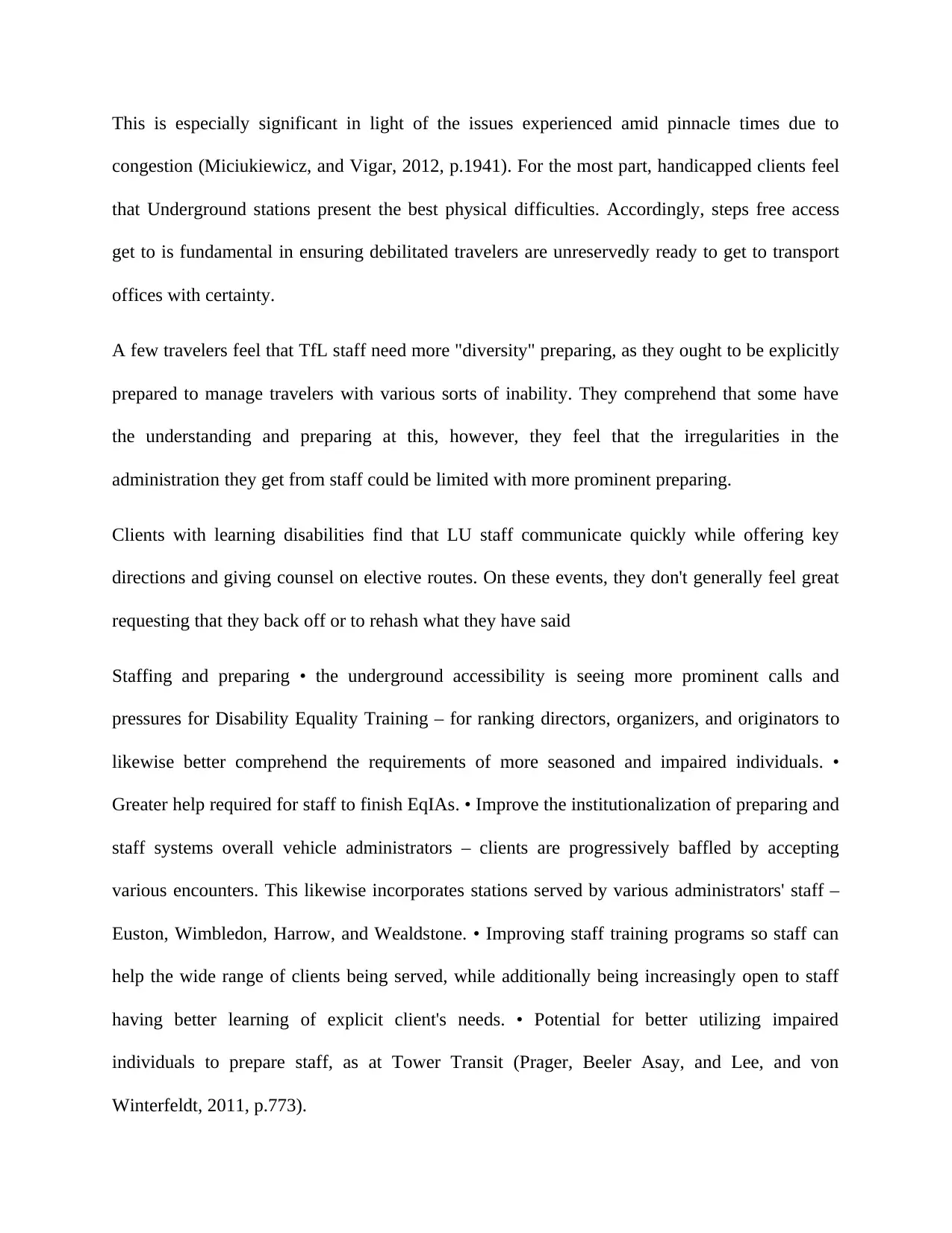
This is especially significant in light of the issues experienced amid pinnacle times due to
congestion (Miciukiewicz, and Vigar, 2012, p.1941). For the most part, handicapped clients feel
that Underground stations present the best physical difficulties. Accordingly, steps free access
get to is fundamental in ensuring debilitated travelers are unreservedly ready to get to transport
offices with certainty.
A few travelers feel that TfL staff need more "diversity" preparing, as they ought to be explicitly
prepared to manage travelers with various sorts of inability. They comprehend that some have
the understanding and preparing at this, however, they feel that the irregularities in the
administration they get from staff could be limited with more prominent preparing.
Clients with learning disabilities find that LU staff communicate quickly while offering key
directions and giving counsel on elective routes. On these events, they don't generally feel great
requesting that they back off or to rehash what they have said
Staffing and preparing • the underground accessibility is seeing more prominent calls and
pressures for Disability Equality Training – for ranking directors, organizers, and originators to
likewise better comprehend the requirements of more seasoned and impaired individuals. •
Greater help required for staff to finish EqIAs. • Improve the institutionalization of preparing and
staff systems overall vehicle administrators – clients are progressively baffled by accepting
various encounters. This likewise incorporates stations served by various administrators' staff –
Euston, Wimbledon, Harrow, and Wealdstone. • Improving staff training programs so staff can
help the wide range of clients being served, while additionally being increasingly open to staff
having better learning of explicit client's needs. • Potential for better utilizing impaired
individuals to prepare staff, as at Tower Transit (Prager, Beeler Asay, and Lee, and von
Winterfeldt, 2011, p.773).
congestion (Miciukiewicz, and Vigar, 2012, p.1941). For the most part, handicapped clients feel
that Underground stations present the best physical difficulties. Accordingly, steps free access
get to is fundamental in ensuring debilitated travelers are unreservedly ready to get to transport
offices with certainty.
A few travelers feel that TfL staff need more "diversity" preparing, as they ought to be explicitly
prepared to manage travelers with various sorts of inability. They comprehend that some have
the understanding and preparing at this, however, they feel that the irregularities in the
administration they get from staff could be limited with more prominent preparing.
Clients with learning disabilities find that LU staff communicate quickly while offering key
directions and giving counsel on elective routes. On these events, they don't generally feel great
requesting that they back off or to rehash what they have said
Staffing and preparing • the underground accessibility is seeing more prominent calls and
pressures for Disability Equality Training – for ranking directors, organizers, and originators to
likewise better comprehend the requirements of more seasoned and impaired individuals. •
Greater help required for staff to finish EqIAs. • Improve the institutionalization of preparing and
staff systems overall vehicle administrators – clients are progressively baffled by accepting
various encounters. This likewise incorporates stations served by various administrators' staff –
Euston, Wimbledon, Harrow, and Wealdstone. • Improving staff training programs so staff can
help the wide range of clients being served, while additionally being increasingly open to staff
having better learning of explicit client's needs. • Potential for better utilizing impaired
individuals to prepare staff, as at Tower Transit (Prager, Beeler Asay, and Lee, and von
Winterfeldt, 2011, p.773).
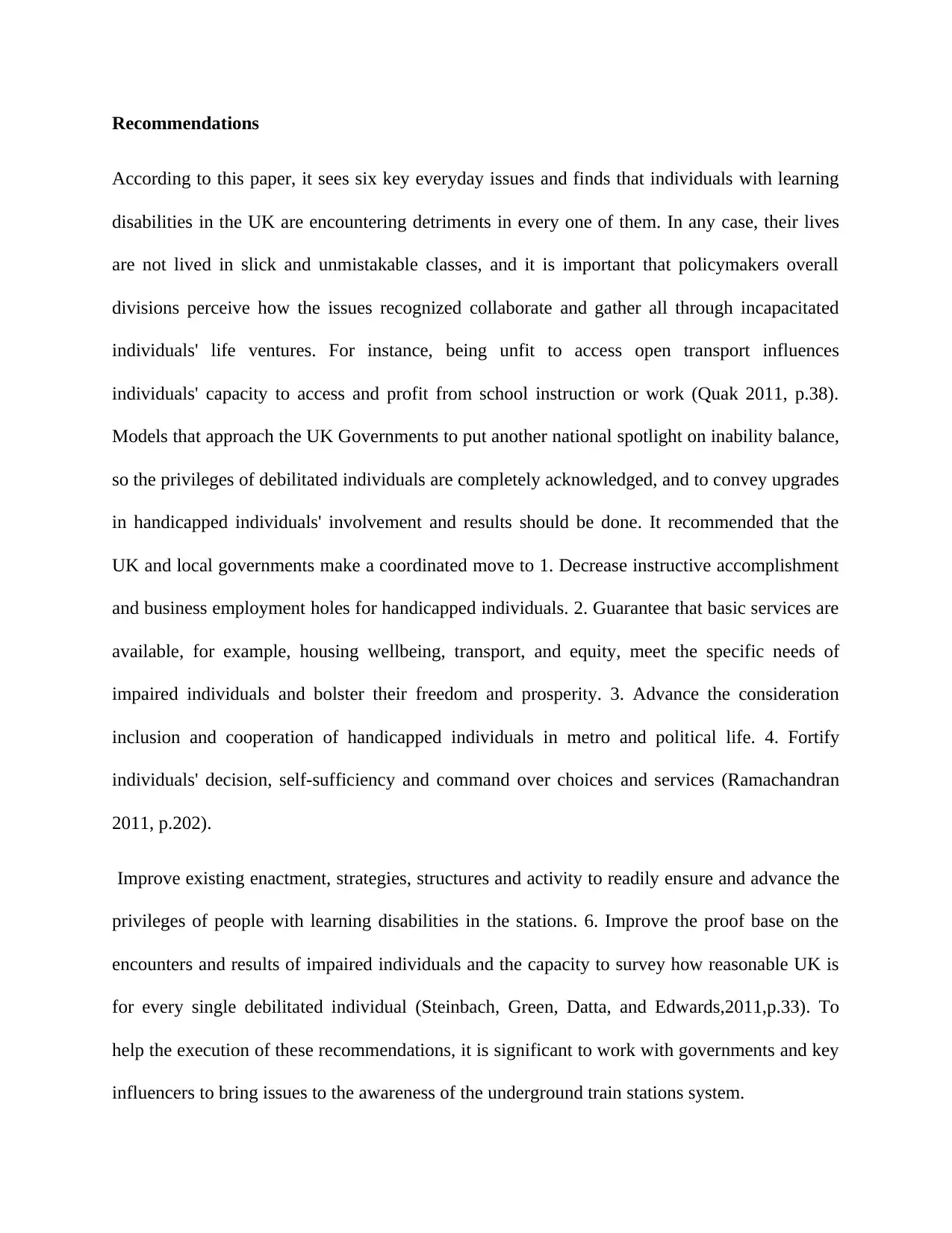
Recommendations
According to this paper, it sees six key everyday issues and finds that individuals with learning
disabilities in the UK are encountering detriments in every one of them. In any case, their lives
are not lived in slick and unmistakable classes, and it is important that policymakers overall
divisions perceive how the issues recognized collaborate and gather all through incapacitated
individuals' life ventures. For instance, being unfit to access open transport influences
individuals' capacity to access and profit from school instruction or work (Quak 2011, p.38).
Models that approach the UK Governments to put another national spotlight on inability balance,
so the privileges of debilitated individuals are completely acknowledged, and to convey upgrades
in handicapped individuals' involvement and results should be done. It recommended that the
UK and local governments make a coordinated move to 1. Decrease instructive accomplishment
and business employment holes for handicapped individuals. 2. Guarantee that basic services are
available, for example, housing wellbeing, transport, and equity, meet the specific needs of
impaired individuals and bolster their freedom and prosperity. 3. Advance the consideration
inclusion and cooperation of handicapped individuals in metro and political life. 4. Fortify
individuals' decision, self-sufficiency and command over choices and services (Ramachandran
2011, p.202).
Improve existing enactment, strategies, structures and activity to readily ensure and advance the
privileges of people with learning disabilities in the stations. 6. Improve the proof base on the
encounters and results of impaired individuals and the capacity to survey how reasonable UK is
for every single debilitated individual (Steinbach, Green, Datta, and Edwards,2011,p.33). To
help the execution of these recommendations, it is significant to work with governments and key
influencers to bring issues to the awareness of the underground train stations system.
According to this paper, it sees six key everyday issues and finds that individuals with learning
disabilities in the UK are encountering detriments in every one of them. In any case, their lives
are not lived in slick and unmistakable classes, and it is important that policymakers overall
divisions perceive how the issues recognized collaborate and gather all through incapacitated
individuals' life ventures. For instance, being unfit to access open transport influences
individuals' capacity to access and profit from school instruction or work (Quak 2011, p.38).
Models that approach the UK Governments to put another national spotlight on inability balance,
so the privileges of debilitated individuals are completely acknowledged, and to convey upgrades
in handicapped individuals' involvement and results should be done. It recommended that the
UK and local governments make a coordinated move to 1. Decrease instructive accomplishment
and business employment holes for handicapped individuals. 2. Guarantee that basic services are
available, for example, housing wellbeing, transport, and equity, meet the specific needs of
impaired individuals and bolster their freedom and prosperity. 3. Advance the consideration
inclusion and cooperation of handicapped individuals in metro and political life. 4. Fortify
individuals' decision, self-sufficiency and command over choices and services (Ramachandran
2011, p.202).
Improve existing enactment, strategies, structures and activity to readily ensure and advance the
privileges of people with learning disabilities in the stations. 6. Improve the proof base on the
encounters and results of impaired individuals and the capacity to survey how reasonable UK is
for every single debilitated individual (Steinbach, Green, Datta, and Edwards,2011,p.33). To
help the execution of these recommendations, it is significant to work with governments and key
influencers to bring issues to the awareness of the underground train stations system.
⊘ This is a preview!⊘
Do you want full access?
Subscribe today to unlock all pages.

Trusted by 1+ million students worldwide
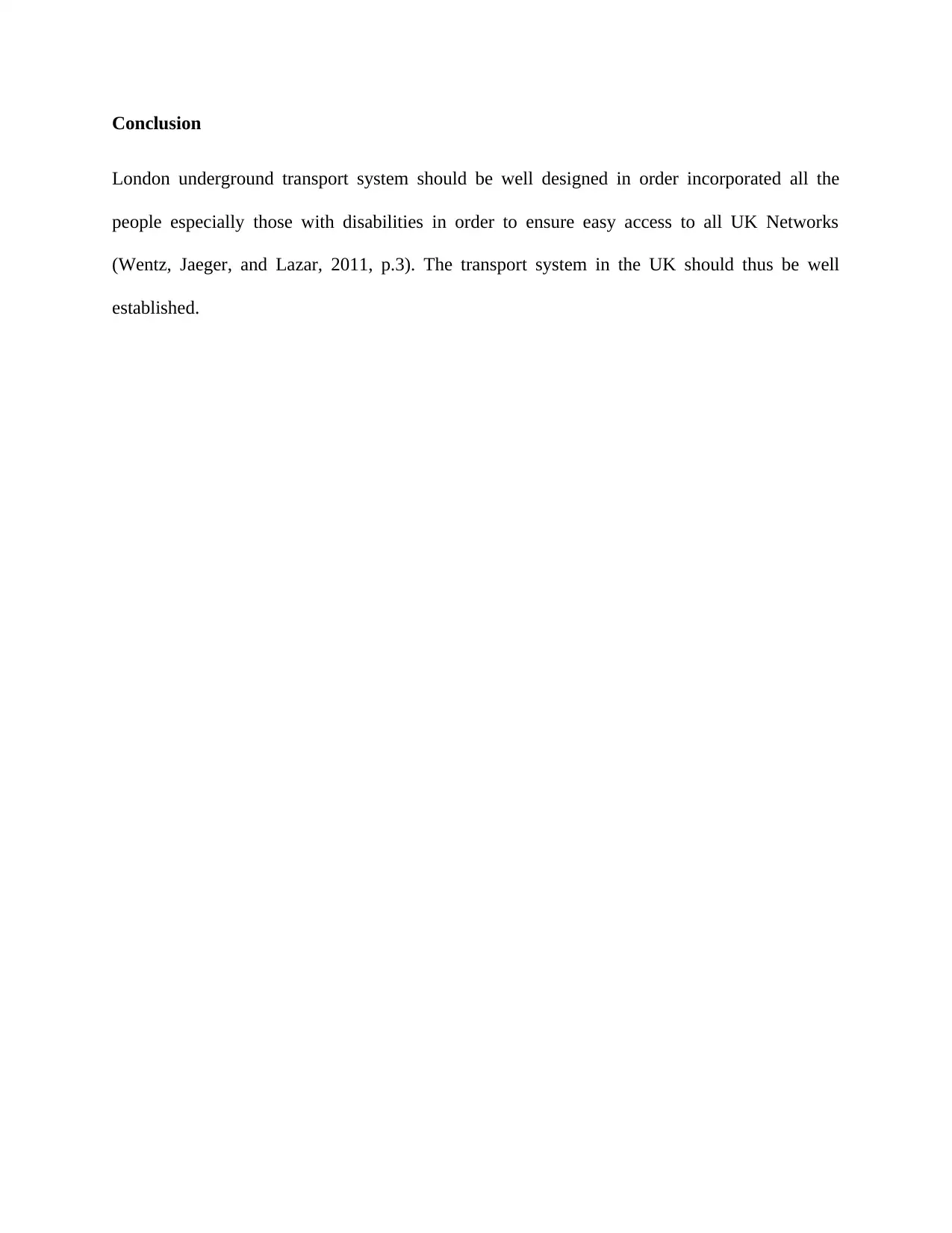
Conclusion
London underground transport system should be well designed in order incorporated all the
people especially those with disabilities in order to ensure easy access to all UK Networks
(Wentz, Jaeger, and Lazar, 2011, p.3). The transport system in the UK should thus be well
established.
London underground transport system should be well designed in order incorporated all the
people especially those with disabilities in order to ensure easy access to all UK Networks
(Wentz, Jaeger, and Lazar, 2011, p.3). The transport system in the UK should thus be well
established.
Paraphrase This Document
Need a fresh take? Get an instant paraphrase of this document with our AI Paraphraser
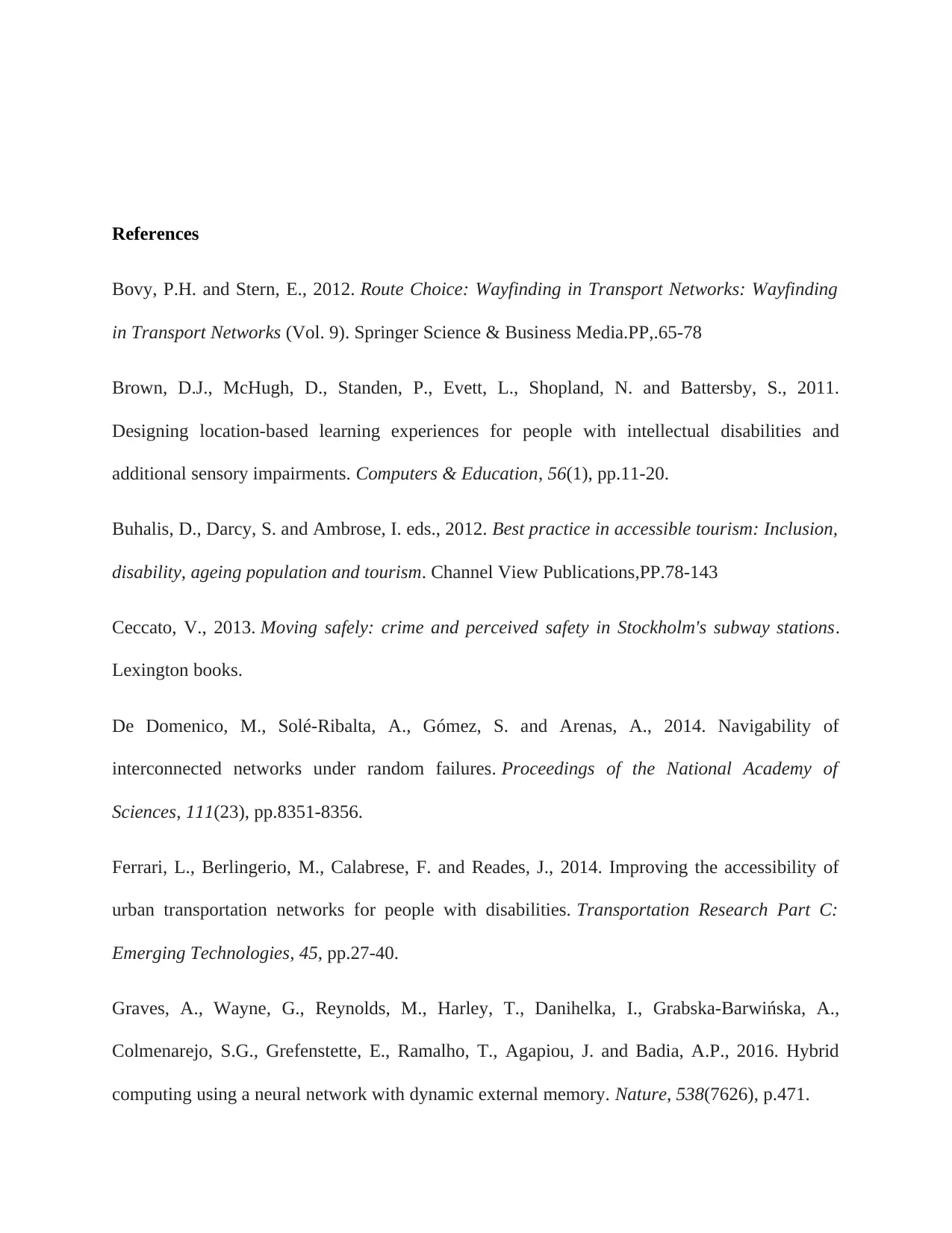
References
Bovy, P.H. and Stern, E., 2012. Route Choice: Wayfinding in Transport Networks: Wayfinding
in Transport Networks (Vol. 9). Springer Science & Business Media.PP,.65-78
Brown, D.J., McHugh, D., Standen, P., Evett, L., Shopland, N. and Battersby, S., 2011.
Designing location-based learning experiences for people with intellectual disabilities and
additional sensory impairments. Computers & Education, 56(1), pp.11-20.
Buhalis, D., Darcy, S. and Ambrose, I. eds., 2012. Best practice in accessible tourism: Inclusion,
disability, ageing population and tourism. Channel View Publications,PP.78-143
Ceccato, V., 2013. Moving safely: crime and perceived safety in Stockholm's subway stations.
Lexington books.
De Domenico, M., Solé-Ribalta, A., Gómez, S. and Arenas, A., 2014. Navigability of
interconnected networks under random failures. Proceedings of the National Academy of
Sciences, 111(23), pp.8351-8356.
Ferrari, L., Berlingerio, M., Calabrese, F. and Reades, J., 2014. Improving the accessibility of
urban transportation networks for people with disabilities. Transportation Research Part C:
Emerging Technologies, 45, pp.27-40.
Graves, A., Wayne, G., Reynolds, M., Harley, T., Danihelka, I., Grabska-Barwińska, A.,
Colmenarejo, S.G., Grefenstette, E., Ramalho, T., Agapiou, J. and Badia, A.P., 2016. Hybrid
computing using a neural network with dynamic external memory. Nature, 538(7626), p.471.
Bovy, P.H. and Stern, E., 2012. Route Choice: Wayfinding in Transport Networks: Wayfinding
in Transport Networks (Vol. 9). Springer Science & Business Media.PP,.65-78
Brown, D.J., McHugh, D., Standen, P., Evett, L., Shopland, N. and Battersby, S., 2011.
Designing location-based learning experiences for people with intellectual disabilities and
additional sensory impairments. Computers & Education, 56(1), pp.11-20.
Buhalis, D., Darcy, S. and Ambrose, I. eds., 2012. Best practice in accessible tourism: Inclusion,
disability, ageing population and tourism. Channel View Publications,PP.78-143
Ceccato, V., 2013. Moving safely: crime and perceived safety in Stockholm's subway stations.
Lexington books.
De Domenico, M., Solé-Ribalta, A., Gómez, S. and Arenas, A., 2014. Navigability of
interconnected networks under random failures. Proceedings of the National Academy of
Sciences, 111(23), pp.8351-8356.
Ferrari, L., Berlingerio, M., Calabrese, F. and Reades, J., 2014. Improving the accessibility of
urban transportation networks for people with disabilities. Transportation Research Part C:
Emerging Technologies, 45, pp.27-40.
Graves, A., Wayne, G., Reynolds, M., Harley, T., Danihelka, I., Grabska-Barwińska, A.,
Colmenarejo, S.G., Grefenstette, E., Ramalho, T., Agapiou, J. and Badia, A.P., 2016. Hybrid
computing using a neural network with dynamic external memory. Nature, 538(7626), p.471.
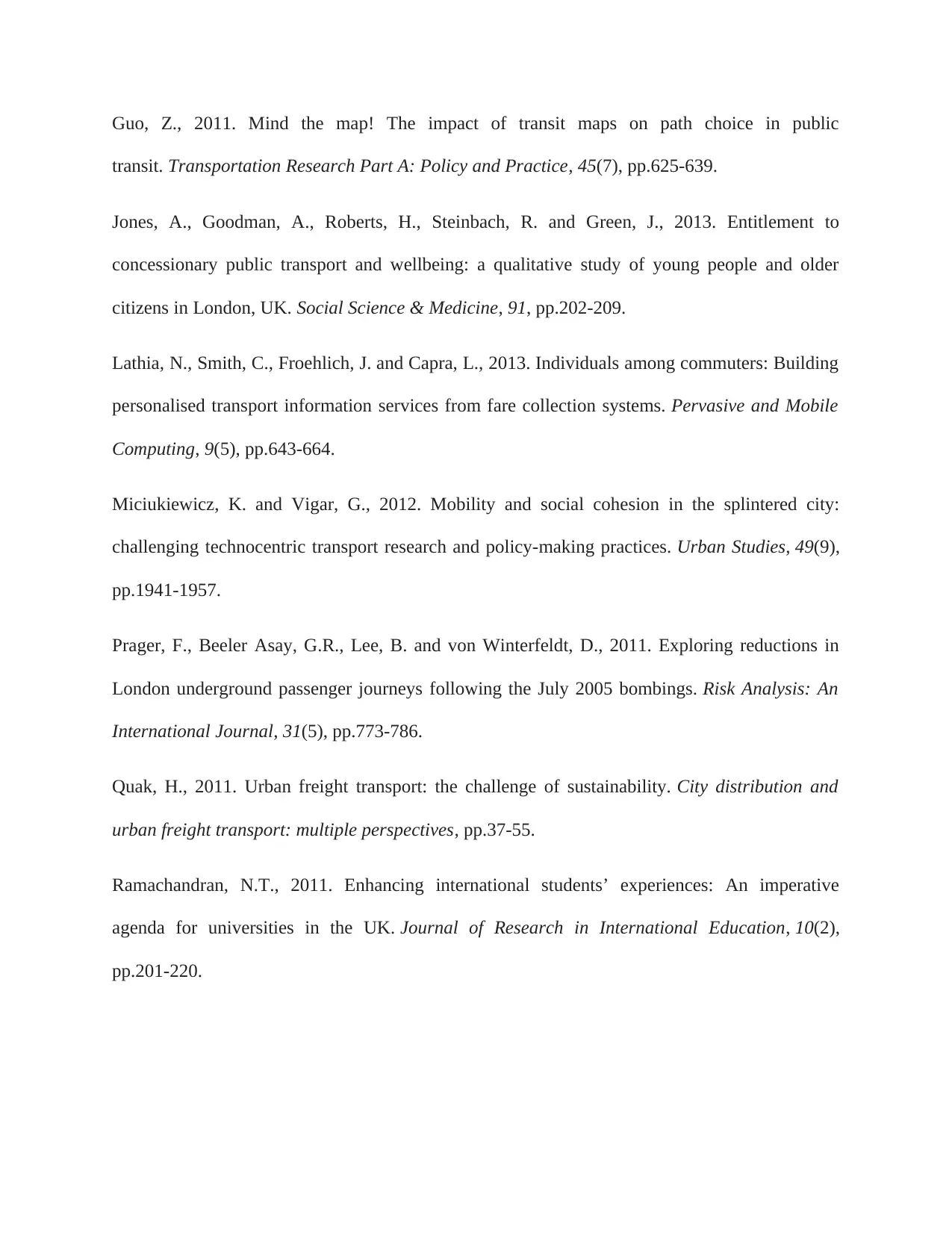
Guo, Z., 2011. Mind the map! The impact of transit maps on path choice in public
transit. Transportation Research Part A: Policy and Practice, 45(7), pp.625-639.
Jones, A., Goodman, A., Roberts, H., Steinbach, R. and Green, J., 2013. Entitlement to
concessionary public transport and wellbeing: a qualitative study of young people and older
citizens in London, UK. Social Science & Medicine, 91, pp.202-209.
Lathia, N., Smith, C., Froehlich, J. and Capra, L., 2013. Individuals among commuters: Building
personalised transport information services from fare collection systems. Pervasive and Mobile
Computing, 9(5), pp.643-664.
Miciukiewicz, K. and Vigar, G., 2012. Mobility and social cohesion in the splintered city:
challenging technocentric transport research and policy-making practices. Urban Studies, 49(9),
pp.1941-1957.
Prager, F., Beeler Asay, G.R., Lee, B. and von Winterfeldt, D., 2011. Exploring reductions in
London underground passenger journeys following the July 2005 bombings. Risk Analysis: An
International Journal, 31(5), pp.773-786.
Quak, H., 2011. Urban freight transport: the challenge of sustainability. City distribution and
urban freight transport: multiple perspectives, pp.37-55.
Ramachandran, N.T., 2011. Enhancing international students’ experiences: An imperative
agenda for universities in the UK. Journal of Research in International Education, 10(2),
pp.201-220.
transit. Transportation Research Part A: Policy and Practice, 45(7), pp.625-639.
Jones, A., Goodman, A., Roberts, H., Steinbach, R. and Green, J., 2013. Entitlement to
concessionary public transport and wellbeing: a qualitative study of young people and older
citizens in London, UK. Social Science & Medicine, 91, pp.202-209.
Lathia, N., Smith, C., Froehlich, J. and Capra, L., 2013. Individuals among commuters: Building
personalised transport information services from fare collection systems. Pervasive and Mobile
Computing, 9(5), pp.643-664.
Miciukiewicz, K. and Vigar, G., 2012. Mobility and social cohesion in the splintered city:
challenging technocentric transport research and policy-making practices. Urban Studies, 49(9),
pp.1941-1957.
Prager, F., Beeler Asay, G.R., Lee, B. and von Winterfeldt, D., 2011. Exploring reductions in
London underground passenger journeys following the July 2005 bombings. Risk Analysis: An
International Journal, 31(5), pp.773-786.
Quak, H., 2011. Urban freight transport: the challenge of sustainability. City distribution and
urban freight transport: multiple perspectives, pp.37-55.
Ramachandran, N.T., 2011. Enhancing international students’ experiences: An imperative
agenda for universities in the UK. Journal of Research in International Education, 10(2),
pp.201-220.
⊘ This is a preview!⊘
Do you want full access?
Subscribe today to unlock all pages.

Trusted by 1+ million students worldwide
1 out of 13
Your All-in-One AI-Powered Toolkit for Academic Success.
+13062052269
info@desklib.com
Available 24*7 on WhatsApp / Email
![[object Object]](/_next/static/media/star-bottom.7253800d.svg)
Unlock your academic potential
Copyright © 2020–2025 A2Z Services. All Rights Reserved. Developed and managed by ZUCOL.
